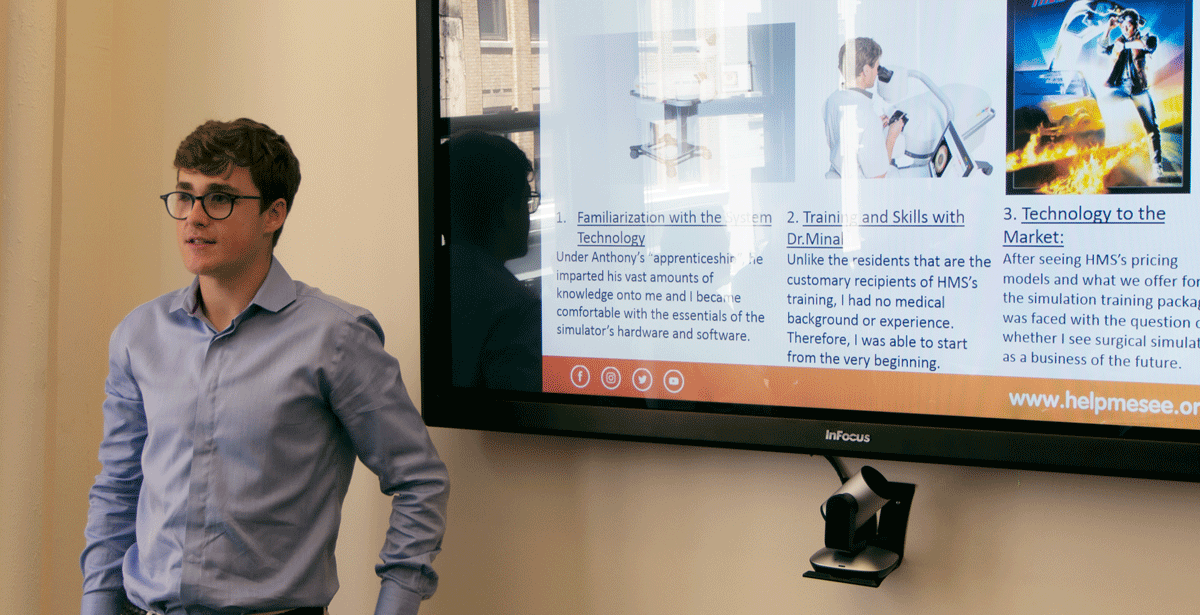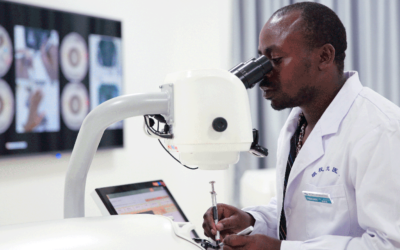The following is a letter from our Summer Intern MacCoy Weil will be attending American University in London as a freshman this Fall. Many thanks to MacCoy for his contributions during his time here in the HelpMeSee New York office.
It is estimated that cataracts are responsible for the total blindness of about 20 million people throughout the world and the seriously impaired vision of about another 80 million. It is the mission of HelpMeSee to restore vision in as many as possible of these unfortunate individuals, many of whom live in impoverished areas with no access to ophthalmic medical care.
In order to carry out this mission, HelpMeSee, led by CEO, Mr. Jacob Mohan Thazhathu, has a staff of 41 unique and talented people around the world. Furthermore, as a non-profit organization, most of their funding comes from philanthropic donations, but they are also developing a training program whereas funds raised from this arm of the organization will be used to train specialists in developing countries on Manual Small Incision Cataract Surgery. Over the past two weeks, I have had the privilege of working with most of these inspiring and intelligent individuals who come together to form the HelpMeSee enterprise that continues to make a positive difference in the world.
Upon my arrival, one of the very first things I did was familiarize myself with not only the office and with my new coworkers but delve into the inner workings of the Simulator. I was immediately captivated by the glorious machines, desperately wanting to learn more. To my pleasant surprise, Biomedical Simulator Technician, Anthony DeSantis didn’t hesitate either and we went straight to work.
Before laying a finger on anything, I was given a history of HelpMeSee and the development of their Eye Surgery Simulator. There were multiple models that preceded the one in front of me today, but even the most primitive version surpassed most ophthalmological technology standards. If Anthony were to ask my unsuspecting self how long I thought the company had been around for by looking at their “miniature museum,” I can guarantee that I would have guessed around 15-20 years. I know now that this speculation would have been off by a large margin. I digress; the point that I am trying to convey from my experience here is that this company’s rate of change and growth is unbelievable. The simulators were not even there for the first couple of years! Then, I started to learn about all the different constituents that went into the simulator.
I never anticipated that so many other companies had to work with HelpMeSee in creating both the Simulator’s hardware and software. Moog is a company that is based in Amsterdam and specializes in creating high-performance motion control solutions. They played an especially integral part in creating the Simulators because they were essentially the “architects” that brought the HelpMeSee idea to life. In the very beginning, we came to Moog and asked them to help and create a Simulator for us (with their haptics technology included). They agreed, and we gave them specific guidelines and criteria. Moog was then able to make everything that we asked for, but because they were only a haptic technology company, extra help was needed. SenseGraphics, Insimo, and Harman were all brought in to help with the graphics, physics, SIA, SBLS, and more. Moog was the original link, but today HelpMeSee works directly with the other three companies. What an incredible array of work coming together! Finally, more connections were made with other businesses because there were certain parts that we needed. Long story short, by the end of my first day, I already had a great appreciation for work that went into making the Simulator that I have been privileged to use every day.
On the second day, my history lesson came to an end, but when a door closes another one opens. We started to analyze the Simulator before us and look at how it functions. HelpMeSee’s current surgical Simulator contains many different parts. Some of the most notable pieces are its 3 PC’s, a dime-sized graphics chip, and 2 multipurpose handpieces with live haptic feedback. The PC’s control the real-time and simulation by converting analog into digital signals. They also coordinate with the User Interface. This is a very small amount of information (and there is a plethora of things that I didn’t mention and do not know), but my time spent grasping the foundations of the Simulator on the second day proved valuable for the remaining duration of my volunteer program. In fact, I passed the qualification test for “Simulator Technology Training Level 1,” which means that I supposedly have a sufficient amount of knowledge for me to be an instructor or demonstrator (this is probably true because I demonstrated many times over the two weeks!).
I am incredibly grateful towards Anthony for imparting a fraction of his wisdom onto me. He knows everything there is to know about the Simulator and learning from him made my experience even more memorable! Even with an iota of accumulated knowledge, I can completely calibrate the Simulator, turn it on and reach a point where I can do a surgery myself (poorly if I may add!), and troubleshoot in case there is a problem.
As I slowly started to become more knowledgeable and informed, I embarked on an adventure that would go on to make the most of my 2 weeks: performing the MSCIS on the Simulator myself. I absorbed everything that I could possibly manage on the anatomy of the eye, surgery terms, and how to perform certain parts of the operation. It was very humbling for me because as soon as I started to find comfort in my primitive understanding of the Simulator, I was back to “square one.” Contrary to what some may think, this was not something to dread. In fact, I was quite elated when I heard that I would have the opportunity to learn from an expert in her respective field, Dr. Mina Baldota. I am most grateful to HelpMeSee for not extinguishing my thirst for knowledge, but for kindling my inquisitive fire even further.
Primarily, in order for me to really comprehend what I would be doing, I needed a solid foundation (which I had none of due to my lack of any form of medical experience!). Therefore, researching MSCIS, astigmatisms, anatomical images of the eye, and looking at a physical model gave me some of the necessary tools for me to start learning. The Manual Small Incision Cataract Surgery eBook was also great; the wide variety of multimedia and friendly user interface made it easy for me to study (while reading it, I was also giving feedback and showing Hina a minor issue that I caught!).
On my first day of training, Dr. Minal Baldota and I had a Zoom call with Dr. Daniel Hutter, so he could critique and help Dr. Minal with how I was being taught. I, on the other hand, was using all my mental capacity towards remembering and employing what I recently studied into the Simulator. Thankfully, Dr. Minal kindly went over some concepts and parts of the surgery with me before we started. I had an absolute ball because I was constantly trying to take in the maze of medical information that I was engulfed in. No one was trying to waste time and we continued to go through different parts of the surgery. My first day in the surgery world was both memorable, filled with mistakes, and great fun.
I owe Dr. Minal my most sincere thanks for regularly taking out the majority of her day to teach and show me what it means to be a surgeon. I will not forget my medical knowledge or experiences because my hard work and great memories are already firmly implanted into my brain.
I have little to no medical knowledge, have worked here for the blink of an eye, and nevertheless have no trouble in recognizing this opportunity. There are many reasons why I find myself firmly agreeing with this conclusion.
Firstly, history is pointing in the direction of promise; HelpMeSee’s parent company, FlightSafety, went through a very similar path (except to train airplane pilots). Both companies have virtually no competitors and a vast audience in need. Therefore, the creativity and hard work of both trailblazing companies have allowed them to ride the cutting edge of technology. If HelpMeSee continues their rate of growth and expansion as they have been doing, I see no major setbacks that will knock them off the wave of the future.
Secondly, the implementation of surgical simulation training for the MSICS (Manual Small Incision Cataract Surgery) gives medical professionals and students alike lots of advantages compared to the almost nonexistent list of cons. I like to think of HelpMeSee’s Simulators as time machines; when operating on an actual eye, pig-eye, or tomato (anything really), you can magically fix your mistakes or go back when you do the incorrect thing? Sadly, the world’s technological capabilities are exceeded by the notion of time travel! But, our Simulators are the closest things we have to a “do-over.” The ability to perform certain parts or all the MSCIS as much as one wishes is an incredible tool. Unlike countless examples in history where we do not learn from our mistakes, Simulator training also makes self-analysis and introspection much easier. Imagine if every medical student in the United States trained on these Simulators when learning MSCIS. Furthermore, what if each student was able to accumulate hundreds of hours of experience before touching an actual eye. I am willing to bet my life that if this were to happen, the rates of surgical proficiency would dramatically increase while the number of errors would plummet.
As shown, there seems to be a compelling argument for the utilization of surgery simulators, but this is just the beginning. HelpMeSee focuses on the MSCIS, but there are numerous kinds of cataract operations such as the Phacoemulsification (“Phaco”) and ECCE operations. Therefore, simulators could not only be used for cataract surgeries, but for all kinds of operations. I hope that one day, my great-grandchildren can live in a world where there are training simulators for every kind of surgery.
Even with this information in mind, timeframe seems to remain an enigma. I do not know if this prediction will come true in a day, month, year, or decade, but with almost one hundred million people on earth who are visually impaired with cataracts, surgical simulations can change the world. The more we train, the more we help and grow.
I find myself to be in great debt to many people; to every single person who had the task of crossing paths with me, thank you for playing a part in giving me the internship of a lifetime. I feel like I have been here forever already. The environment that I have been so lucky to be a part of is something I have never seen before. Upon my arrival, I immediately felt welcomed and knew that I was about to embark on a truly special journey. This company has not come close to reaching its full potential, but as time passes, I will make sure to keep a close eye on how HelpMeSee revolutionizes medical technology and the entire healthcare industry.







